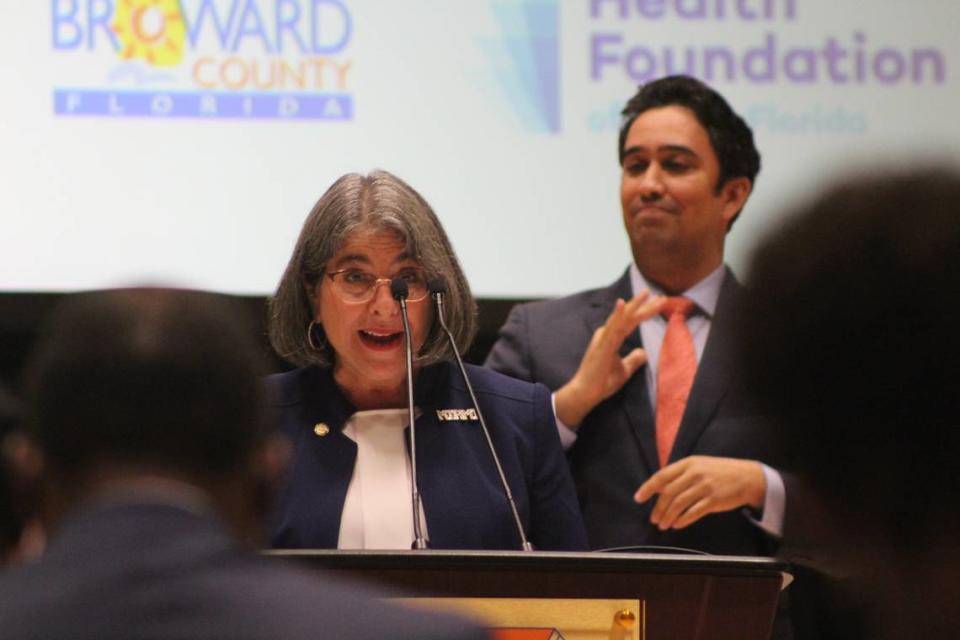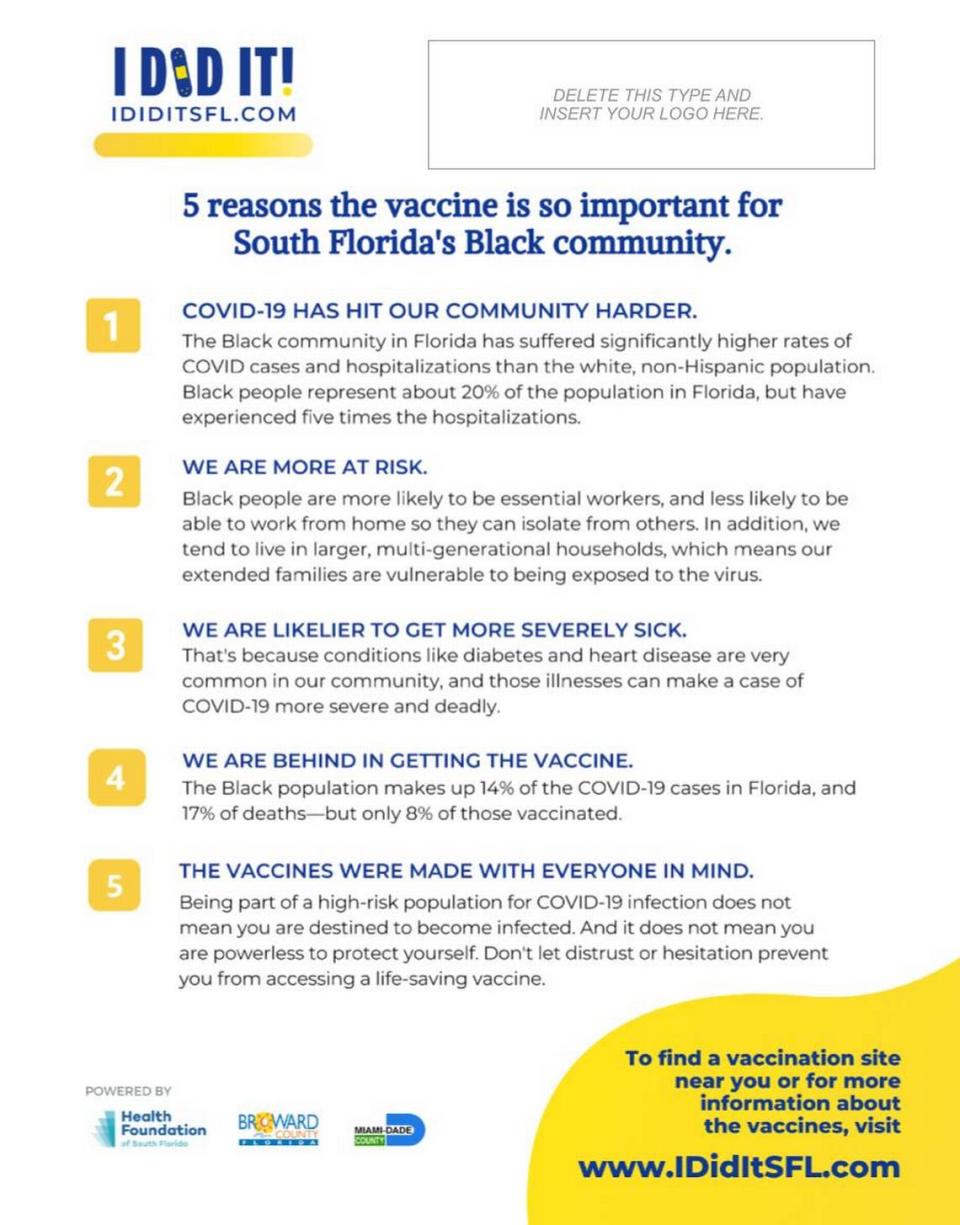Miami-Dade, Broward partner to combat vaccine inequities in Black, Hispanic communities
Black and Hispanic communities aren’t strangers to being marginalized in South Florida, and the coronavirus pandemic has exacerbated that cultural stigma.
A majority of Black residents have yet to receive any dose of the COVID-19 vaccine, even while Miami-Dade County recently surpassed 1 million partially or fully vaccinated residents and Broward County is close behind at more than 750,000 inoculations, according to Florida Department of Health data.
Miami-Dade Mayor Daniella Levine Cava and Broward Mayor Steve Geller now have metaphorically eradicated county lines — along with several commissioners and community members — to resolve this issue.
“I know we have a problem right now and we need to solve it,” Geller said. “In order to solve this we need to have everyone involved.”
Both counties on Wednesday partnered with the Health Foundation of South Florida to kick off the “I Did It!” vaccine education campaign.
“COVID doesn’t respect county lines so our efforts will not respect county lines,” Miami-Dade Vice Chairman Oliver Gilbert said at the campaign’s announcement. “The real world consequence of people not getting vaccinated is people dying.”
The “I Did It!” initiative will aggressively target underserved Black and Hispanic neighborhoods in Miami-Dade and Broward — including Homestead, West Park, Liberty City, Fort Lauderdale’s Sistrunk, Overtown, Little Haiti and Miami Gardens.
“We are going into neighborhoods where people are,” Cava told the Miami Herald. “We’re doing everything we can to make sure there is no excuse. This is a no excuse campaign.”
Through billboards, TV commercials, door-to-door visits and a strong online presence, the campaign hopes to reach residents who may be hesitant in taking the vaccine, an apprehensiveness that some believe stems from a lack of accessible information or declining faith in government institutions.
“The campaign is really about getting people information,” said Loreen Chant, president and CEO of the Health Foundation of South Florida. “We know there’s a lot of disinformation and a lot of hesitancy, yet at the same we also we know the only, safest path forward is to get vaccinated.”
South Florida residents can expect to see informative videos featuring people of diverse races and ethnicities proudly saying they received the vaccine and explaining why they chose to do so, in both English and Spanish.

‘We wanted our campaign to be inspiring and encouraging’
Black residents told the Miami Herald earlier this year that they have felt neglected and left behind by Miami-Dade County throughout the pandemic.
“They knock on doors when it’s time to vote for them, but not knock on doors to [educate] so many African-American people,” Black Community Leader Romania Dukes said in late February.
During the early months of the pandemic, Florida Department of Health data showed Black residents were dying at higher rates than white people.
Despite the absence of restrictions that experts say initially held back the African-American community from getting vaccinated — such as mandatory signed doctor forms — there remains a stark gap in inoculation rates between Black people and their white counterparts.
As of Wednesday, only 16% of the Black population in Miami-Dade and Broward have been partially or fully vaccinated compared to 37% of white Broward residents and 36% of white Miami-Dade residents.
This chasm has prevailed even through the uptick in walk-up sites, which allow residents who do not have the means to set up an appointment online or use a drive-through site as an alternative option for getting a vaccination.
While less restrictions and more options haven’t yet proven to close the gap, the Black community is also facing historical vaccine hesitancy and distrust in the healthcare system.
While the origins of this uncertainty is debated, one historical example was the “Tuskegee Study.” About 600 Black men were used as research subjects to examine the history of syphilis and how to treat it among the African-American community, according to historical information from the Centers for Disease Control and Prevention.
The 1932 study was supposed to last six months; however, it went on for 40 years after Black men were misled into giving consent for the study. Even when a treatment for syphilis was found — penicillin — they were never given adequate treatment to treat the disease or the option to leave the study.
With vaccine apprehension and other barriers impacting Black residents, the “I Did It!” push is looking to the community for solutions.
“From the beginning we knew the community needed to be at the heart of the campaign,” Chant said. “We wanted our campaign to be inspiring and encouraging.”
In this spirit, the Health Foundation announced $600,000 in grants would be earmarked to 10 community organizations in Miami-Dade and Broward to specifically work as “trusted messengers” and instill vaccine confidence, Chant said.
“This is not a one-size-fits-all approach,” Chant added. “Our goal and hope is that everyone will see that members in their community have done it, then get more information and realize it is the best way forward.”
Daniella Pierre, president of Miami’s NAACP branch, hopes that this new initiative will allow residents to share their positive experiences about receiving a vaccination.
“I think that story sharing is part of the complete story on how we get to being fully vaccinated and getting herd immunity,” Pierre said. ”All stories matter and I hope it will be inclusive in this initiative.”
Pierre proceeded to say the education campaign is vital and necessary, and outreach from community members can help with hesitancy.
“Our local neighbors, seniors and those who come from the community who have overcome vaccine hesitancy, we need to hear from them,” Pierre said.
Is this the right approach for Hispanic communities?
An emphasis on vaccine education and reducing hesitancy is the same approach the campaign will be taking for South Florida’s Hispanic communities, though the residents contend that may not be the only solution needed.
In Miami-Dade, Hispanics make up 50% of the 1.1 million residents who have been either partially or fully vaccinated, Florida DOH data shows.
But while they are nearly the majority of county residents who received a shot, only 30% of Miami-Dade’s total Hispanic population have gotten one — which is substantially more than the Black community, but still lagging behind white residents.
A county away, Broward is seeing a larger gap in the inoculation rates of its Hispanic population, as they only make up 23% of the more than 750,000 residents who have gotten a shot. Among the entire Broward Hispanic community, only 28% have gotten a vaccine.
The issues that cause this disparity may differ from what ails the Black community. Through a recent survey, interviews with community members and data analysis, the el Nuevo Herald has found evidence that suggests the majority of Miami-Dade Hispanics want to get vaccinated and are doing so at normal rates.
Not being able to miss a work day, lack of legal documentation and not being able to speak English or Spanish (only speaking indigenous Latin American languages), are all nuanced factors that bar Hispanics from getting vaccinated.
The “I Did It!” effort is hoping to help resolve some of these problems, like the language barrier. The campaign’s website notes that it will soon offer educational materials in Portuguese and Creole.
Disinformation and a mistrust in the healthcare industry is as much a factor in the Hispanic community as it is in the Black community, according to experts, and the campaign has created fact sheets to dispel common misconceptions.

A measure of success
The “I Did It!” campaign will be a large effort covering unique neighborhoods with its owns struggles and barriers to vaccination. A standard benchmark to highlight improvement in vaccination rates in such areas wouldn’t be effective, Chant said.
The Health Foundation is working with the Department of Health to create customized baselines for each neighborhood to create a more accurate picture of the campaign’s work.
“I’m excited to look at the data and then sit down and really challenge our partners and ourselves,” Chant said. “[We’ll] ultimately have faith in the community that when we assess the effectiveness of this campaign, we will know we did it. Wouldn’t it be amazing?”

